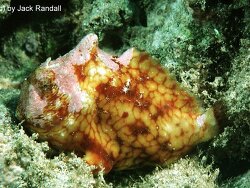Info
Benthic. The average depth for all known captures was 11 m. Individuals maintained in experimental aquaria change in color from dark gray to light cream within 2 weeks. Oviparous. Eggs are bound in ribbon-like sheath or mass of gelatinous mucus called 'egg raft' or 'veil' Fore more Infos click to the Link too fishbase
fishbase: Poisonous to eat
Synonymised names
Antennarius bigibbus Commerson, 1798 · unaccepted
Antennarius tuberosus (Cuvier, 1817) · unaccepted
Antennarius unicornis Bennett, 1827 · unaccepted
Chironectes reticulatus Eydoux & Souleyet, 1850 · unaccepted
Chironectes tuberosus Cuvier, 1817 · unaccepted
Lophius bigibbus Latreille, 1804 · unaccepted







 AndiV
AndiV









